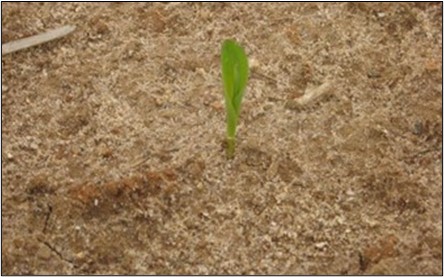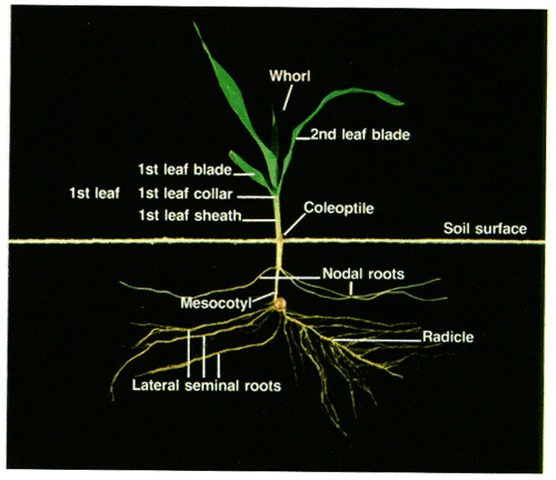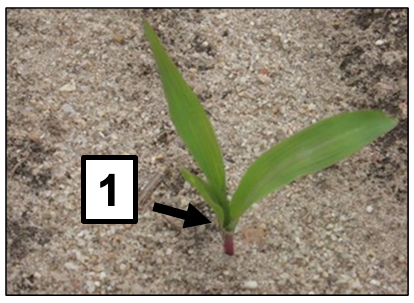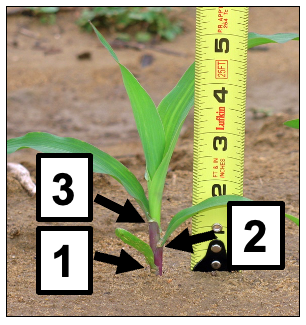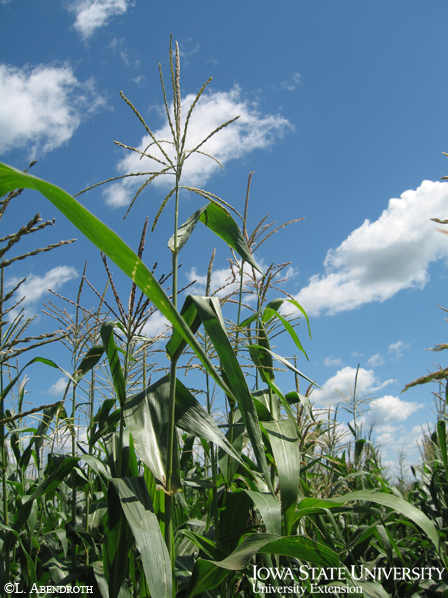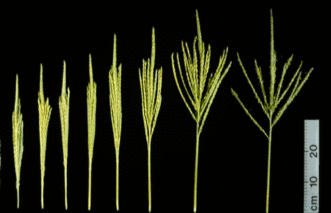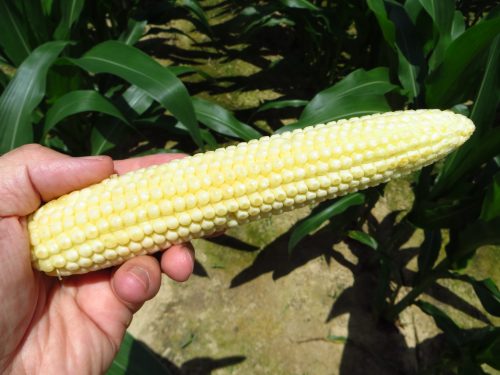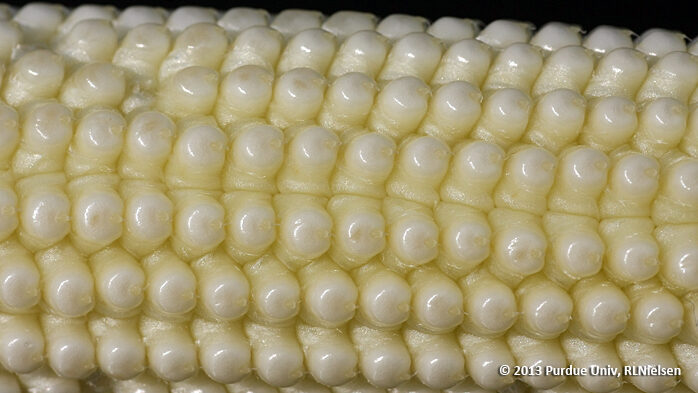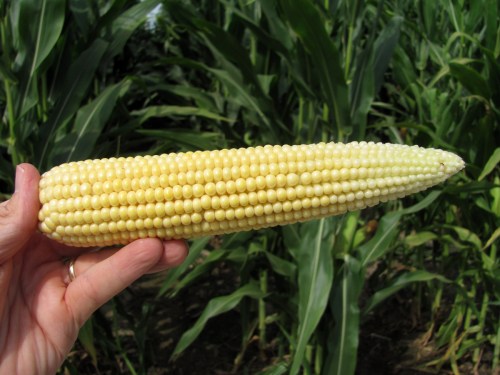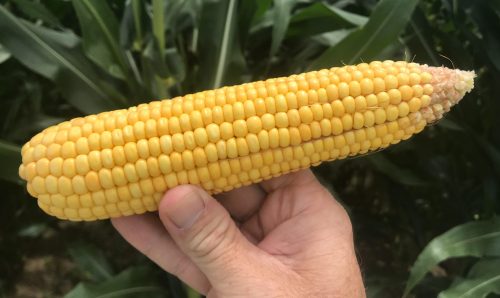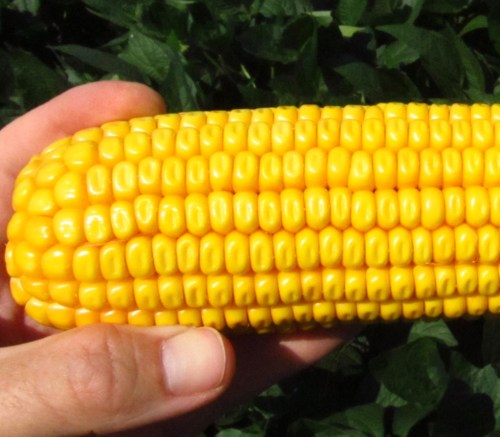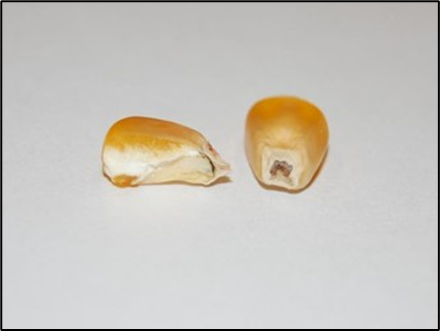Identifying corn growth stages is essential for successful crop management of pests, irrigation, and fertility. This guide will help growers, consultants, Extension, and research personnel properly identify corn growth stages in field corn hybrids.
Generally, corn growth and development can be divided into vegetative (V) and reproductive (R) growth stages. The beginning of each stage starts when at least 50% of plants in the area are at that stage.1,2,3 The vegetative growth stage begins with corn emergence and is completed by tasseling. The reproductive growth stages start with silking and end when a black layer forms, indicating physiological maturity.
Vegetative (V) Growth Stages
Vegetative growth stages of corn progress through leaf stages, which are designated V1, V2, V3, etc., through V(n), where (n) represents the last vegetative stage prior to initiation of reproductive growth stages. Pictures of each stage and a description of that stage are presented below.
VE Stage
Vegetative growth stages in corn begin with seedling emergence (VE stage) (figure 1). Prior to germination, the corn seed absorbs water equal to approximately 50% of its weight.2,3 Once germination begins, the mesocotyl, which connects the developing root with the developing shoot, pushes the coleoptile, or developing shoot, to the soil surface. During this time, the developing root, known as the primary root, begins to grow downward in the opposite direction and develops lateral roots making up the seminal root system (figure 2).2,3,4 This seminal root system absorbs water and nutrients until the V3 growth stage.3
Following emergence, the coleoptile and mesocotyl elongation stop. The growth continues from the growing point (stem apex), located just above the mesocotyl and below the soil surface until the V5–V6 growth stage. The rapidly developing embryonic leaves grow through the coleoptile tip.2,3
V1, V2, V3 to V(n) Stages
Stages between VE and VT are designated numerically as V1, V2, …through V(n). The (n) represents the stage with the top leaf fully expanded before the VT stage. A leaf is considered fully expanded if a leaf collar (the discolored line between the leaf blade and leaf sheath) is visible (figure 3 and figure 4).2,3
VT Stage
Vegetative growth stages in corn cease with the production of a tassel, VT. This stage occurs when a tassel is fully extended (figure 5 and figure 6) prior to the production of silks (figure 7). Tassels will be visible for approximately two to three days before the formation of silks.2,3 This growth stage indicates the total vegetative growth that will occur on the plant, with all the leaves present.
Reproductive (R) Growth Stages
The reproductive stages of corn progress through six growth stages before reaching physiological maturity. Pictures of each stage and a description of that stage are presented below.
R1 and R2 Stages
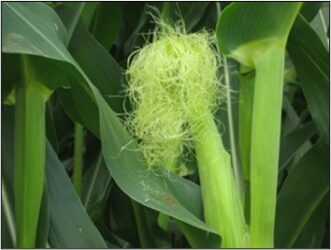
Figure 7. R1 occurs when silks are first visible outside the husks. Image credit: Michael Plumblee, Clemson University.
At the R1 growth stage, or silking (figure 7), silks are first visible outside the husks. Silks emerge at the base growing towards the tip of the developing ear in two to five days and remain receptive to pollen for up to two weeks.2,5 Pollination occurs when falling pollen grains from the tassel are caught by the silks. For successful pollination, it is important that silks emerge and pollinate simultaneously. Moisture stress during this stage causes poor pollination and reduced seed set, reducing yield.
R2, or blister stage (figure 8), occurs when the kernels begin to expand, dare white on the outside, and have a blistered appearance (figure 9). This growth stage typically occurs ten to fourteen days after R1, with silks beginning to dry down and turn brown.2,5,6,7
R3 and R4 Stages
In the R3, or milk growth stage (figure 10), the kernel is pale yellow outside and filled with a milk-colored fluid which is mainly starch. Kernels at this stage have 80% moisture. This growth stage typically occurs eighteen to twenty-two days after R1.2,5,6,7
In the R4, or dough stage (figure 11), starch continues to accumulate and thickens to a pasty consistency. As the kernels develop through the R4 stage, they begin to expand and turn darker yellow. This growth stage typically occurs twenty-four to twenty-eight days after R1.2,5,6,7
R5 and R6 Stages
In the R5, or dent stage (figure 12), most kernels are dented. The kernels at the R5 stage are drying down, beginning at the top, where a small hard white layer of starch forms. The line indicating the hard starch layer will advance toward the base of the kernel. This growth stage occurs approximately thirty-five to forty-two days after R1.2,3,6,7
R6, or the black layer (figure 13), occurs when the hard starch layer has advanced completely to the cob and formed a brown or black abscission layer (black layer) right above the kernel tip. The “black layer” is an indication of physiological maturity, and kernels are at their maximum dry matter weight. Kernels at the R6 stage have 30% to 35% moisture content. This growth stage occurs approximately fifty-five to sixty-five days after R1.2,5,6
References Cited
- Abendroth LJ, Elmore RW, Boyer M J, Marlay SK. Corn growth and development. Ames (IA): Iowa State University Cooperative Extension Service; 2011. PMR 1009.
- Larson E. How to determine corn vegetative growth stages. Starkville (MS): Mississippi State University Extension; 2022 [accessed 2023 Feb 17]. https://www.mississippi-crops.com/2022/05/06/how-to-determine-corn-vegetative-growth-stages/.
- Plumblee MT, editor. South Carolina corn production guide. Clemson (SC): Clemson University Cooperative Extension; 2022. https://www.clemson.edu/extension/agronomy/_files/corn-production-guide.pdf.
- Sáenz Rodríguez MN, Cassab GI. Primary root and mesocotyl elongation in maize seedlings: two organs with antagonistic growth below the soil surface. Plants. 2021;10(7):1274. doi:10.3390/plants10071274. PMID: 34201525; PMCID: PMC8309072.
- Hanway JJ. How a corn plant develops. Ames (IA): Iowa State University of Science and Technology Cooperative Extension Service; 1996 Sep. Special Report No. 48.
- Larson E. Identifying corn reproductive stages and management implications. Starkville (MS): Mississippi State University Extension; 2022 [accessed 2023 Feb 17]. https://www.mississippi-crops.com/2022/07/14/identifying-corn-reproductive-stages-and-management-implications/.
- Nielsen RL. Grain Fill Stages in Corn. West Lafayette (IN): Purdue University, Department of Agronomy, Corny News Network Articles; 2004 Jul 5.

